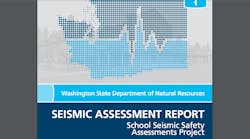Washington state study says earthquakes pose serious risk to schools
A study of more than 200 school buildings in Washington state has found that many of them would not be safe to occupy if a major earthquake occurred.
The study by the state’s Department of Natural Resources and Office of the Superintendent of Public Instruction looked at 222 schools around the state—5% of Washington’s permanent school buildings.
The assessment that researchers used concluded that 43%—95 of 222 buildings—pose a “high” or “very high” risk for loss of life in a strong earthquake. About one-fourth of buildings studied would not be repairable following a major earthquake, and might require demolition.
“Washington State has many older school buildings that are vulnerable to earthquakes,” the study’s executive summary says. “Older unreinforced masonry buildings and non-ductile concrete buildings are especially at risk. Buildings constructed prior to 1975, when the statewide building code was adopted, are particularly vulnerable.”
The study found that older unreinforced masonry buildings and non-ductile concrete school buildings are especially at risk. Facilities built before 1975, when the statewide building code was adopted, are particularly vulnerable.
The assessment also included seismic upgrade cost estimates for 15 buildings in the study and estimated that seismic upgrades in those facilities would range from $63,000 to more than $5 million. But those costs would be less than what would be needed to repair or replace earthquake-damaged facilities.
“The cost to seismically upgrade a vulnerable structure is less or much less than the damage costs the building would incur in an earthquake,” the study says.
Hilary Franz, the state’s Commissioner of Public Lands and head of the Department of Natural Resources, says the study makes it clear that the state needs to more active in addressing seismic safety.
"Our children need and deserve safe schools," Franz says in a news release. "It's a question of when, not if, the next earthquake will hit. We need to be vigilant and take steps now to help keep our kids safe. Taking proactive steps to prevent damage is always smarter and more cost-effective than paying to react and rebuild after disaster strikes."
About the Author
Mike Kennedy
Senior Editor
Mike Kennedy, senior editor, has written for AS&U on a wide range of educational issues since 1999.
